Finite Element Simulation and Experimental Research on Uniformity Regulation of Microwave Heating of Composite Materials
Abstract
:1. Introduction
2. Theoretical Design and Analysis of Microwave Heating Device
2.1. Theory and Dimension Design of Microwave Resonant Cavity
2.2. Finite Element Simulation on Microwave Field Uniformity Optimization
2.2.1. The Basic Theory of Physics for Microwave Heating
2.2.2. Establishment of the Finite Element Model
2.2.3. Design and Selection of Microwave Generator
Influence of Microwave Generator Size on Electric Field Distribution
Influence of the Microwave Generators Quantity and Setting Modes on the Electric Field
2.2.4. Design and Selection of Microwave Mode Stirrer
Size Design of Microwave Mode Stirrer
Influence of the Periodic Rotation of Mode Stirrers on the Electric Field
2.2.5. Design and Selection of Loading Platform
3. Materials and Methods
3.1. Regulating Device of Microwave Heating Uniformity
3.2. Materials and Devices
3.3. Test and Equipment for the Curing Degrees of Resins
3.4. Test and Equipment for the Stresses/Strains during the Microwave Curing Process
4. Results and Discussion
4.1. Verification of Temperature Field Uniformity during Microwave Curing Process
4.2. Effect of Uniformity of Temperature Field on Curing Degree of Composites
4.3. Effect of Uniformity of Temperature Field on Strains/Stresses of Composites
5. Conclusions
Author Contributions
Funding
Institutional Review Board Statement
Informed Consent Statement
Data Availability Statement
Conflicts of Interest
References
- Zhou, S.; Hawley, M.C. A study of microwave reaction rate enhancement effect in adhesive bonding of polymers and composites. Compos. Struct. 2003, 61, 303–309. [Google Scholar] [CrossRef]
- Maenz, S.; Mühlstädt, M.; Jandt, K.D.; Bossert, J. Mechanical properties of microwave cured glass fibre epoxy composites prepared by resin transfer moulding. J. Compos. Mater. 2015, 49, 2839–2847. [Google Scholar] [CrossRef]
- Li, N.; Li, Y.; Hao, X.; Gao, J. A comparative experiment for the analysis of microwave and thermal process induced strains of carbon fiber/bismaleimide composite materials. Compos. Sci. Technol. 2015, 106, 15–19. [Google Scholar] [CrossRef]
- Yang, J. Simulation Study on Heating Efficiency and Uniformity of High Power Rectangular Microwave Reactor. Master’s Thesis, Yunnan Normal University, Kunming, China, 2015. [Google Scholar]
- Thostenson, E.T.; Chou, T.W. Microwave processing: Fundamentals and applications. Compos. Part A-Appl. Sci. 1999, 30, 1055–1071. [Google Scholar] [CrossRef]
- Li, N. Microwave Curing Technologies of Carbon Fiber Reinforced Polymer Composites. Ph.D. Thesis, Nanjing University of Aeronautics and Astronautics, Nanjing, China, 2017. [Google Scholar]
- Zhou, J.; Li, Y.; Li, N.; Hao, X.; Liu, C. Interfacial shear strength of microwave processed carbon fiber/epoxy composites characterized by an improved fiber-bundle pull-out test. Compos. Sci. Technol. 2016, 133, 173–183. [Google Scholar] [CrossRef]
- Chen, X.; Zhan, L.; Pu, Y.; Huang, M.; Wu, X.; Liu, G.; Lin, Z. Effect of cure pressure on microstructure and interlaminar shear strength properties of carbon fiber-reinforced plastics with microwave curing. High Perform. Polym. 2018, 30, 1084–1093. [Google Scholar] [CrossRef]
- Song, L. Design of Microwave-Heated System and Research on Electromagnetic Field in Resonant Cavity. Master’s Thesis, China University of Petroleum (East China), Qingdao, China, 2007. [Google Scholar]
- Li, N.; Li, Y.; Zhou, J.; He, Y.; Hao, X. Drilling delamination and thermal damage of carbon nanotube/carbon fiber reinforced epoxy composites processed by microwave curing. Int. J. Mach. Tools Manuf. 2015, 97, 11–17. [Google Scholar] [CrossRef]
- Guan, C.; Zhan, L.; Liu, G.; Yang, X.; Dai, G.; Jiang, C.; Chen, X. Optimization of a high-pressure microwave curing process for T800/X850 carbon fiber-reinforced plastic. High Perform. Polym. 2020, 32, 30–38. [Google Scholar] [CrossRef]
- Kwak, M.; Robinson, P.; Bismarck, A.; Wise, R. Microwave curing of carbon-epoxy composites: Penetration depth and material characterization. Compos. Part A-Appl. Sci. 2015, 75, 18–27. [Google Scholar] [CrossRef]
- Yi, S.; Liu, L.; Sin, C.K.; Su, F.; Gao, S. A study of microwave curing process for underfill used in flip chip packaging. Part 2: 3D FEM simulation of microwave power distribution inside variable frequency microwave oven. In Proceedings of the IEEE Advanced in Electronic Materials and Packaging, Jeju Island, Korea, 19–22 November 2001. [Google Scholar]
- Plaza-González, P.; Monzó-Cabrera, J.; Catalá-Civera, J.M. Effect of mode-stirrer configurations on dielectric heating performance in multimode microwave applicators. IEEE Trans. Microw. Theory 2005, 53, 1699–1706. [Google Scholar] [CrossRef] [Green Version]
- Huang, Y.; Zhu, X. Microwave oven field uniformity analysis. In Proceedings of the IEEE Antennas and Propagation Society International Symposium, Washington, DC, USA, 3–8 July 2005. [Google Scholar]
- Zhou, J.; Li, Y.; Li, N.; Liu, S.; Cheng, L.; Sui, S.; Gao, J. A multi-pattern compensation method to ensure even temperature in composite materials during microwave curing process. Compos. Part A-Appl. Sci. 2018, 107, 10–20. [Google Scholar] [CrossRef]
- Zhang, R.; Zhong, R. Fundamentals of Microwave Heating Technology, 1st ed.; Electronics Industry Press: Beijing, China, 1988; pp. 50–81. [Google Scholar]
- Lin, Y.E.; Anantheswaran, R.C.; Puri, V.M. Finite element analysis of microwave heating of solid foods. J. Food Eng. 1995, 25, 85–112. [Google Scholar] [CrossRef]
- Zheng, C. The Improvement of the Problem of Sparking in Microwave Oven and the Optimization Design of the Oven. Master’s Thesis, University of Electronic Science and Technology of China, Chengdu, China, 2008. [Google Scholar]
- Liao, Z. Experimental Apparatus Design and Process Study on Microwave Heating Evaporation for Syrup. Master’s Thesis, Guangxi University, Nanning, China, 2009. [Google Scholar]
- Cheng, L. Research on Indirect Microwave Curing of Carbon Fiber Reinforced Polymer Composites. Master’s Thesis, Nanjing University of Aeronautics and Astronautics, Nanjing, China, 2018. [Google Scholar]
- Zhao, H. Research on Key Technologies of Multi-Source and Multi-Frequency Microwave Oven. Master’s Thesis, University of Electronic Science and Technology of China, Chengdu, China, 2019. [Google Scholar]
- Wang, X. Research of Heating Performance Improving with K23L Plate Microwave. Master’s Thesis, University of Electronic Science and Technology of China, Chengdu, China, 2014. [Google Scholar]
- Liu, Y. Research on Novel Waveguides and Devices Based Opon Surface Plasmon Polaritons. Ph.D. Thesis, University of Electronic Science and Technology of China, Chengdu, China, 2019. [Google Scholar]
- Wang, Q. Research on Design and Application of Tunable Dielectric Metamaterials. Ph.D. Thesis, Beijing University of Posts and Telecommunications, Beijing, China, 2020. [Google Scholar]
- Tao, J. Study on the Property and Curing Behavior of Carbon Fiber Prepreg. Master’s Thesis, Donghua University, Shanghai, China, 2016. [Google Scholar]
- Guan, C.; Zhan, L.; Dai, G. Effect of vibration treatment on interfacial strength of microwave curing process for advanced composites. Compos. Interfaces 2021, 28, 237–253. [Google Scholar] [CrossRef]
- Guan, C.; Zhan, L.; Dai, G. A unique method for curing composite materials by introducing vibration treatment into the hybrid heating process. J. Cent. South Univ. 2021, 28, 2961–2972. [Google Scholar] [CrossRef]
- Gopal, A.K.; Adali, S.; Verijenko, V.E. Optimal temperature profiles for minimum residual stress in the cure process of polymer composites. Compos. Struct. 2000, 48, 99–106. [Google Scholar] [CrossRef]
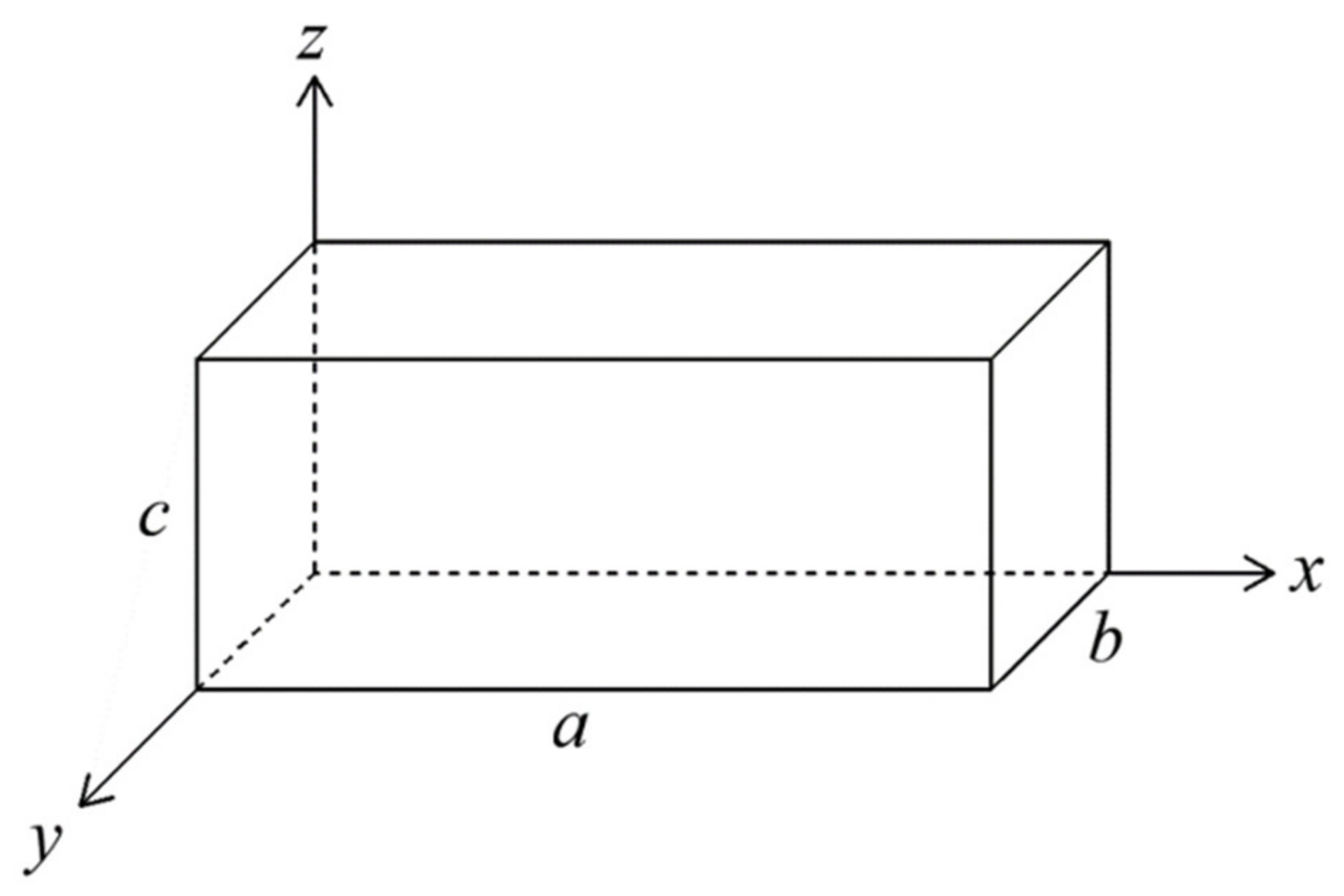
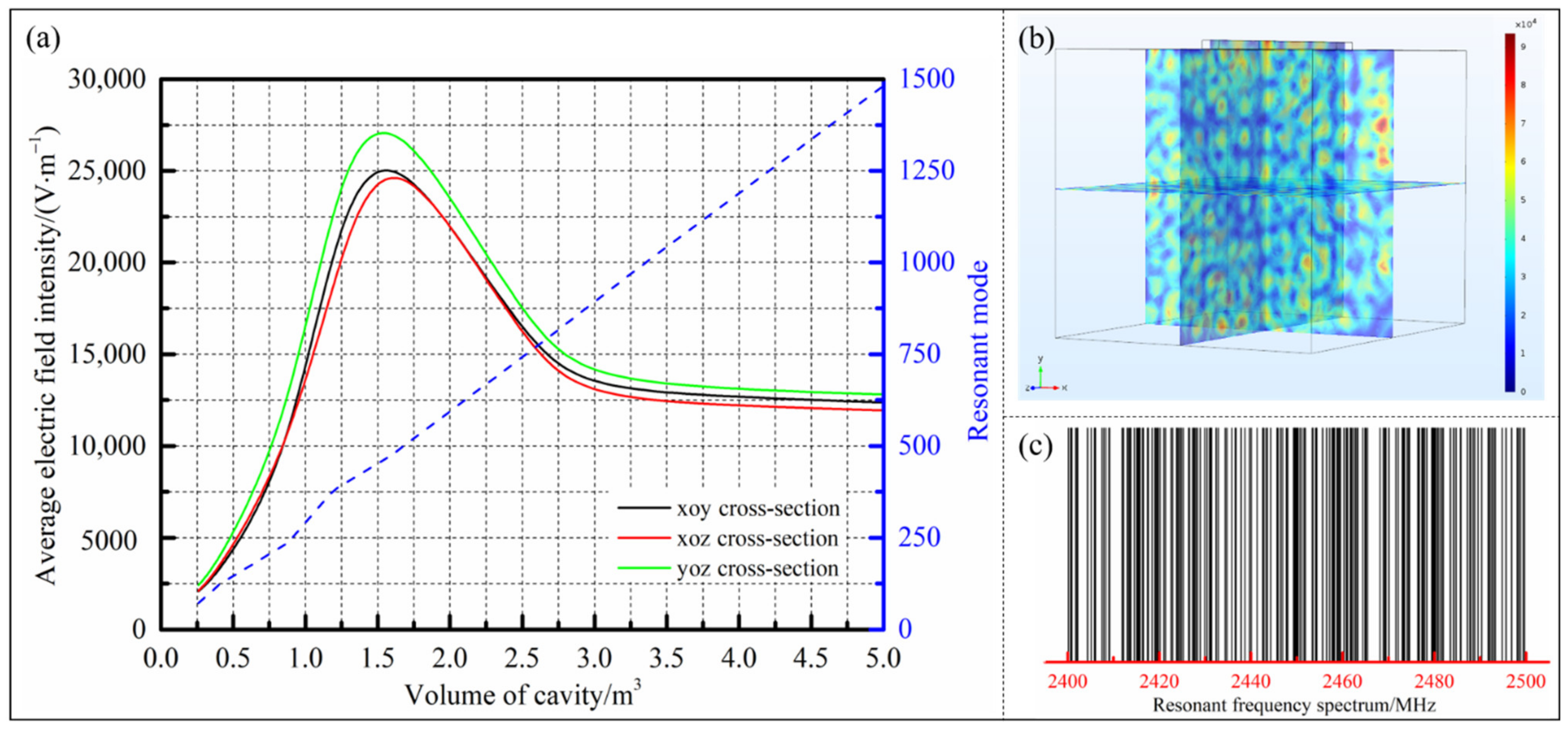
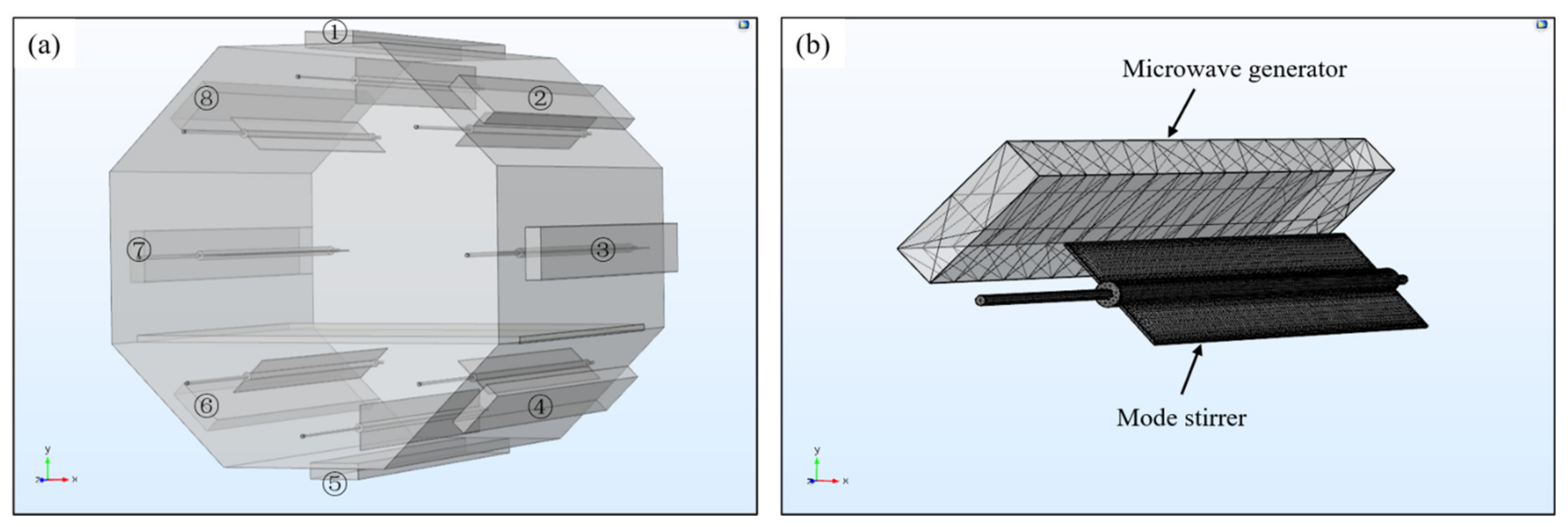
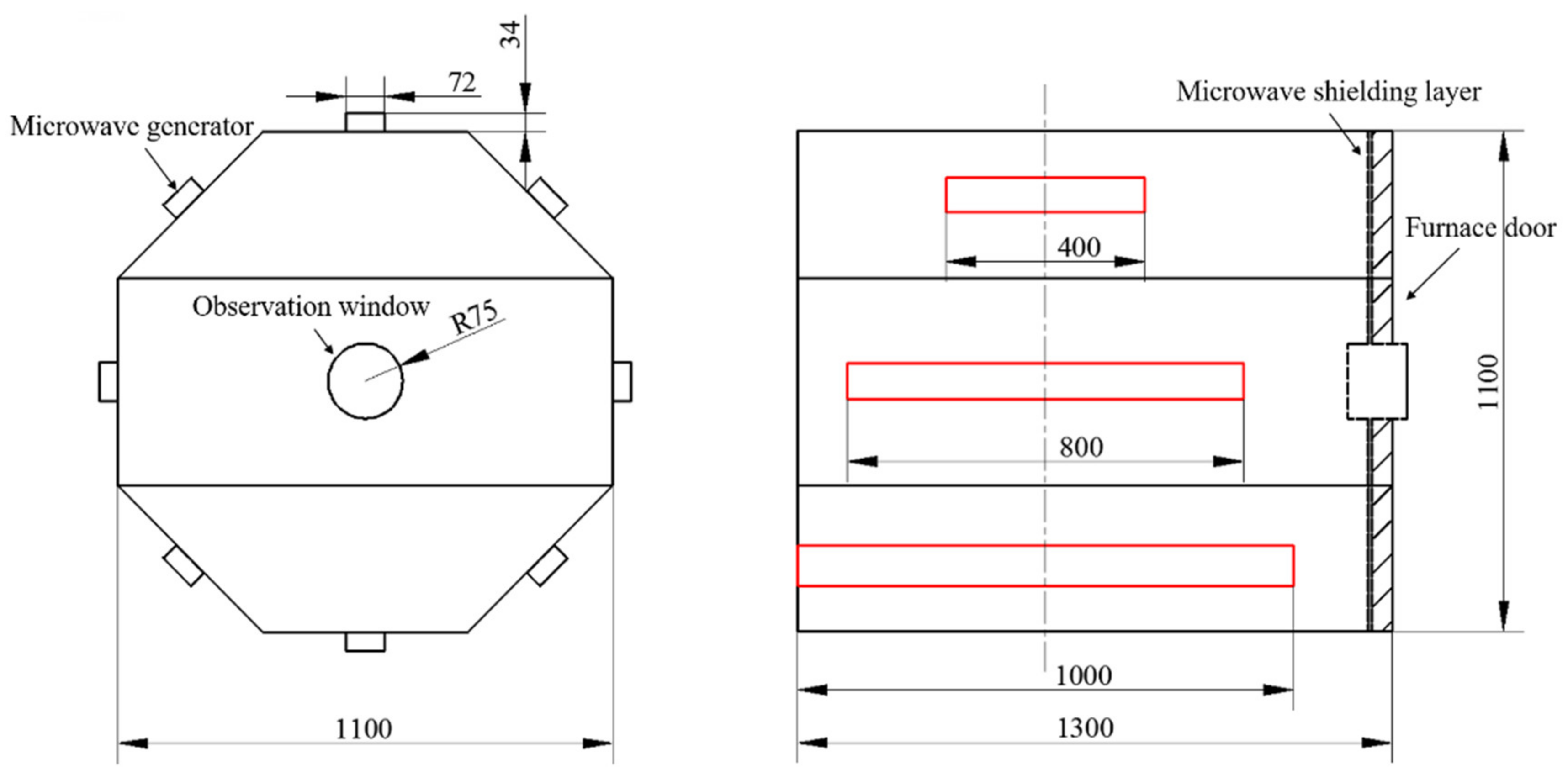
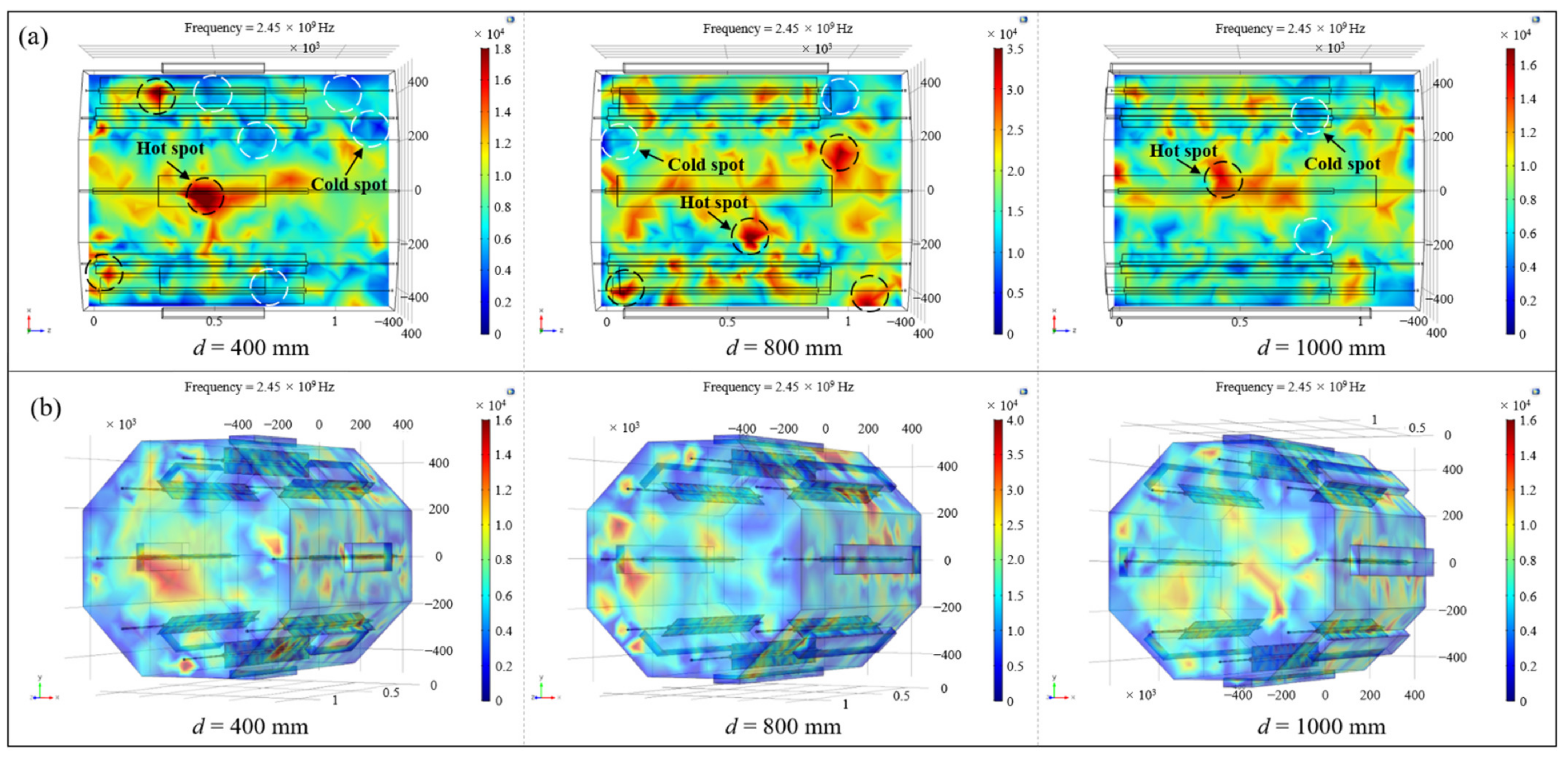
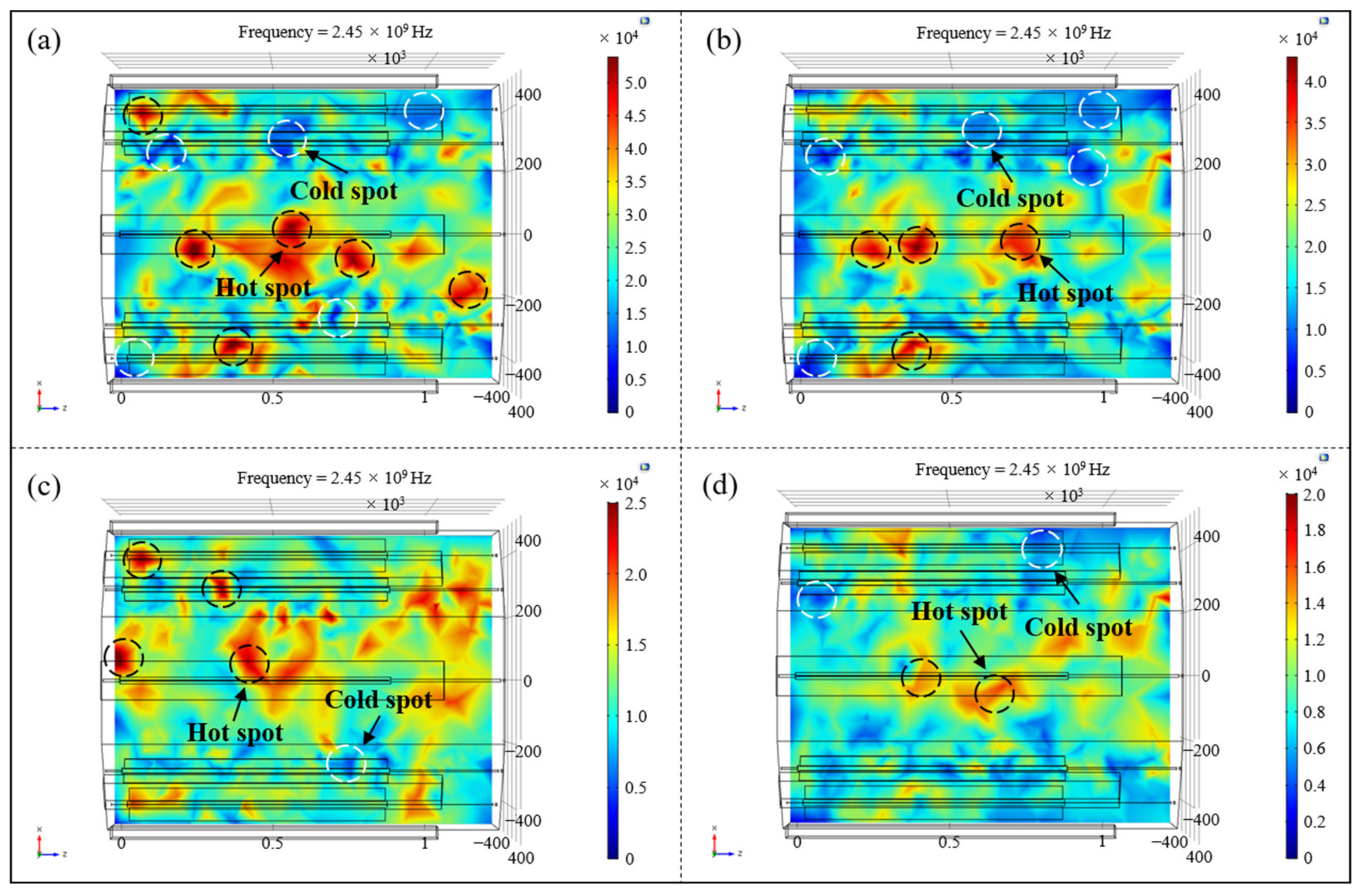


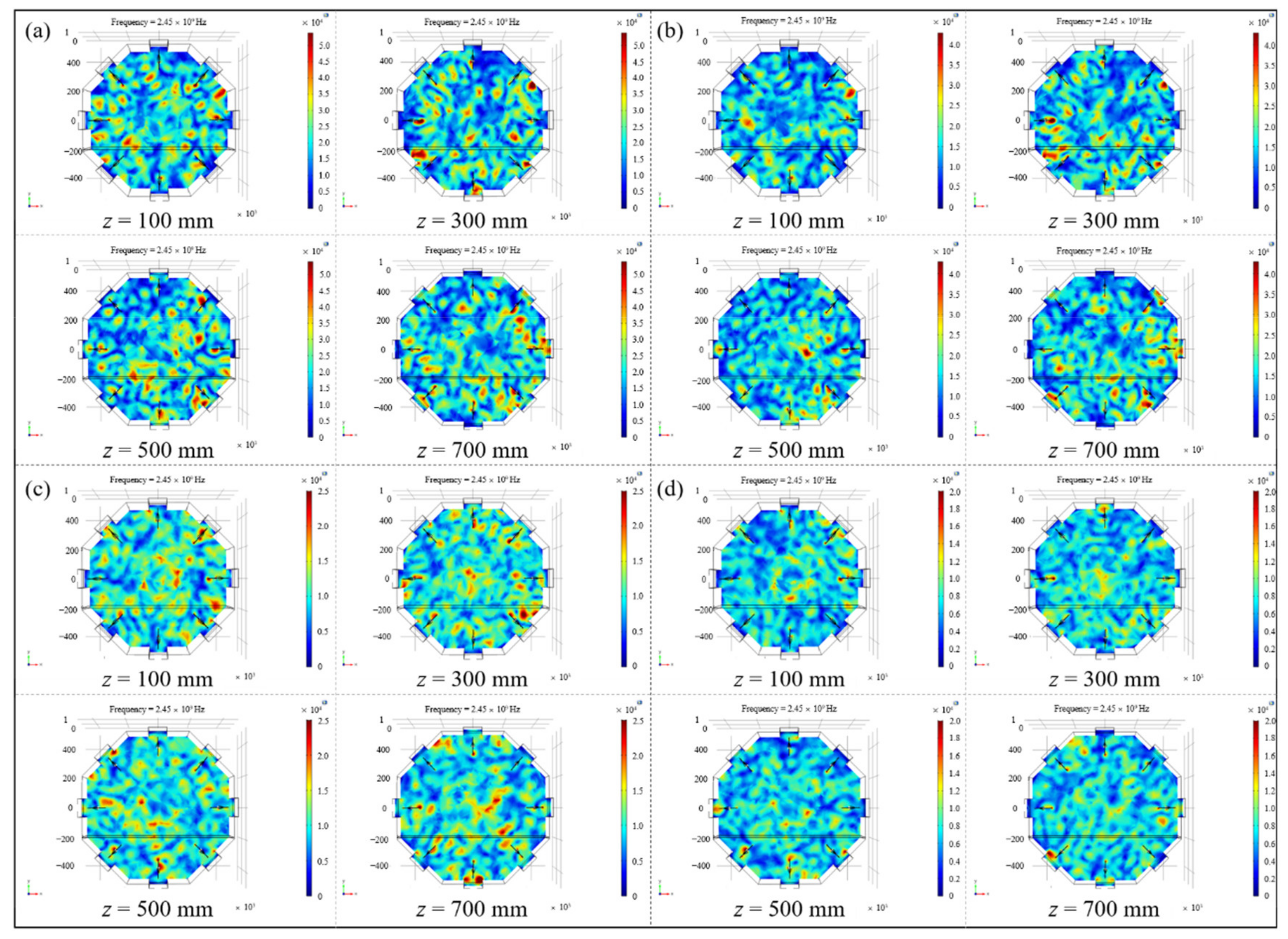
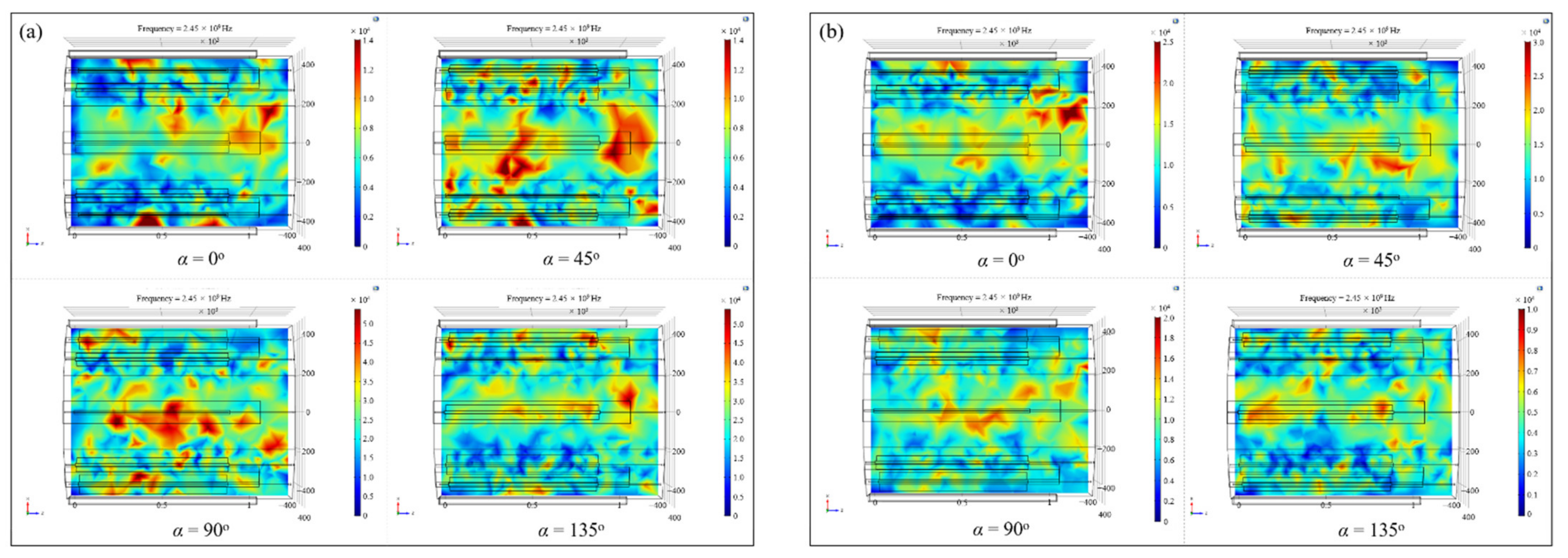
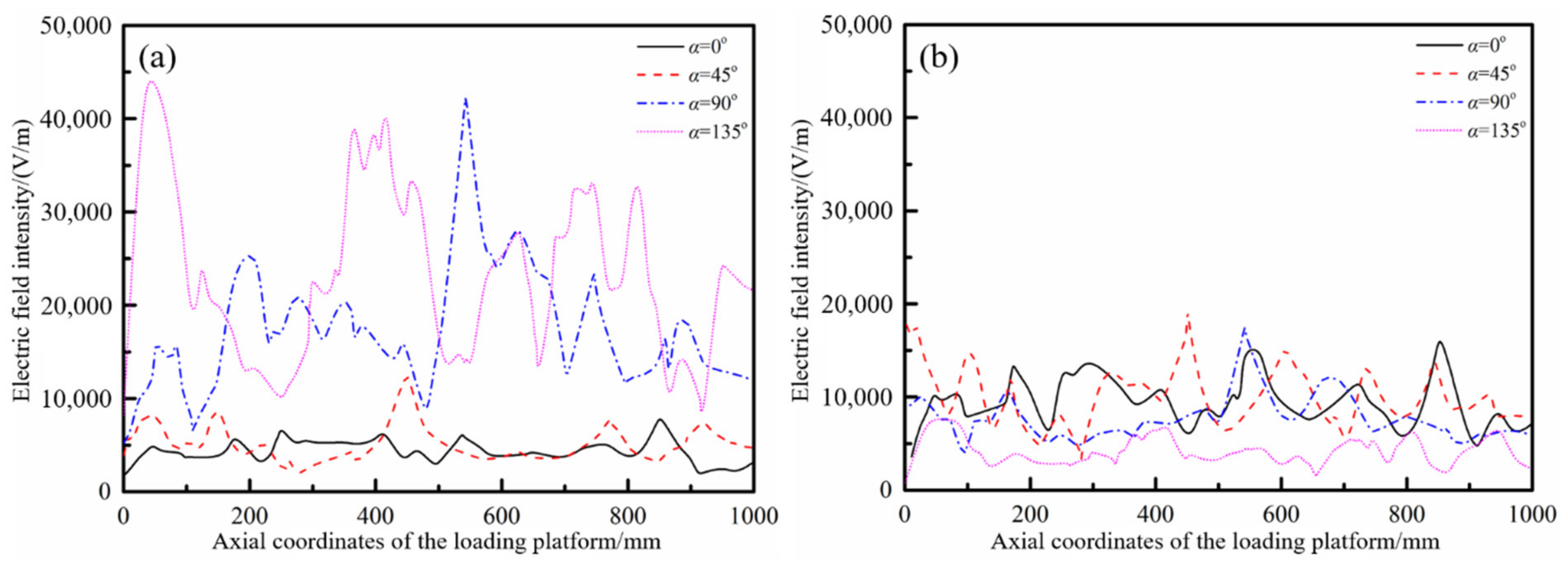
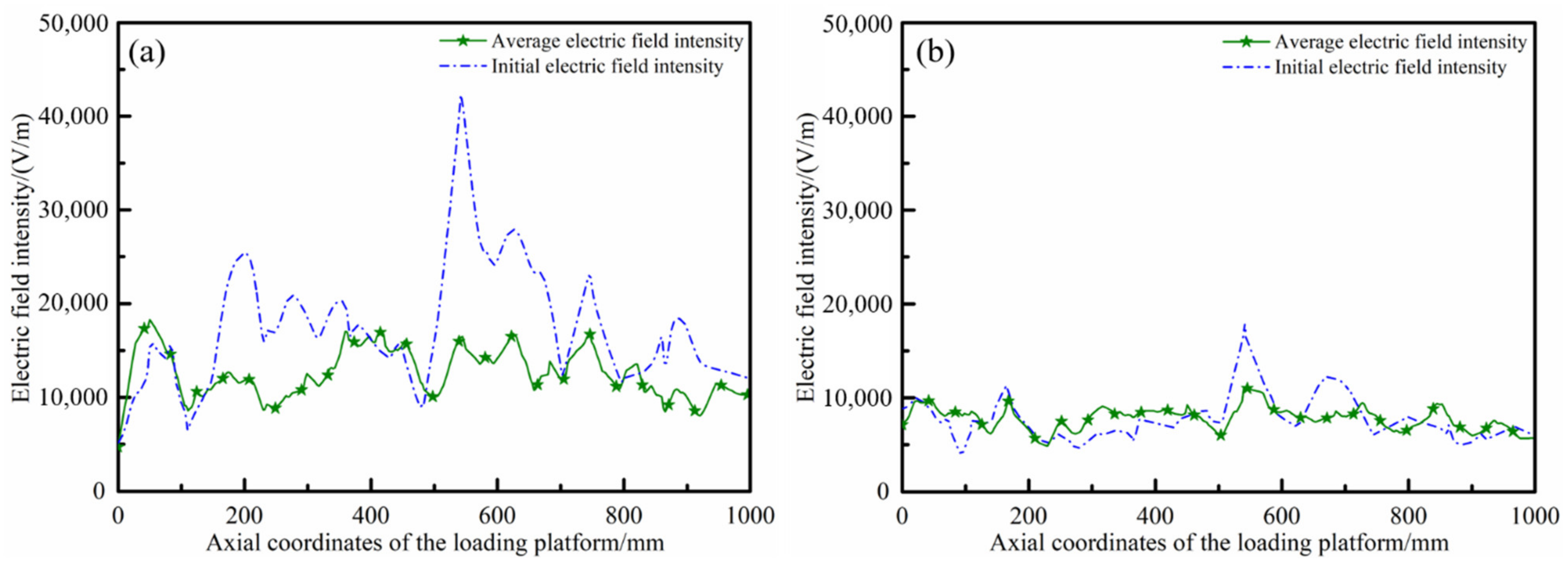
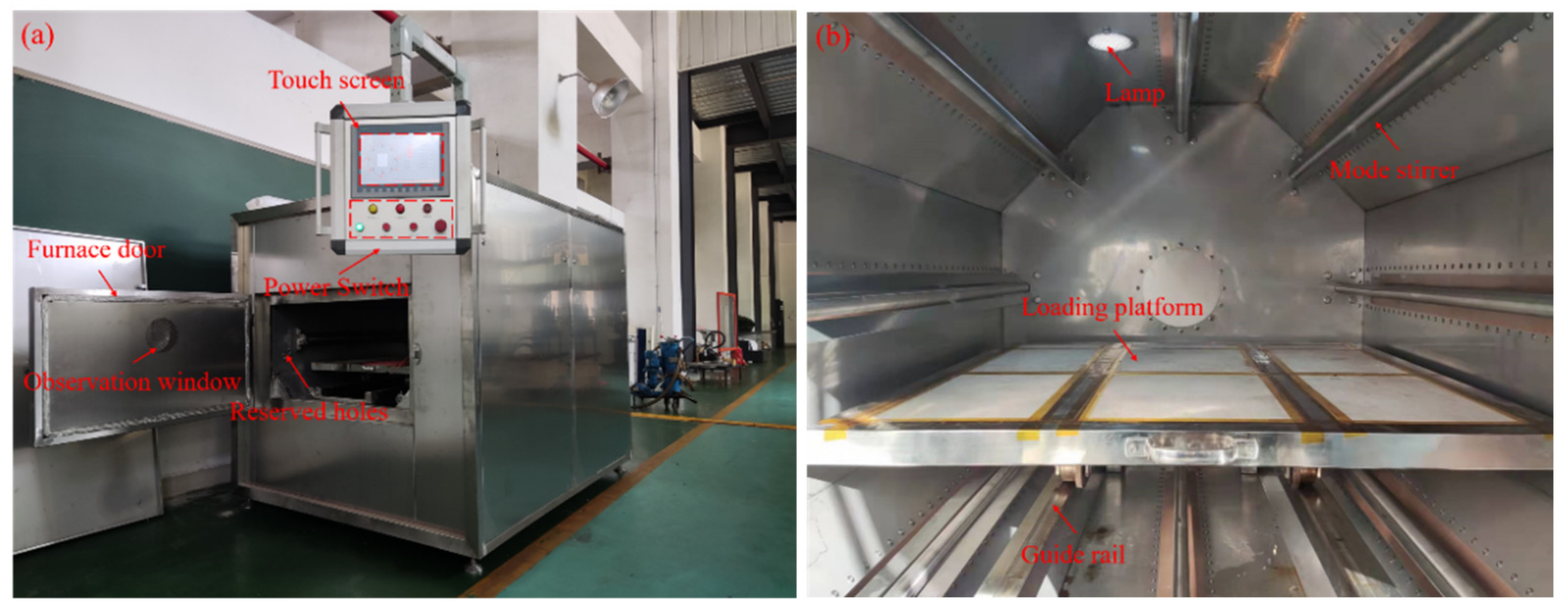
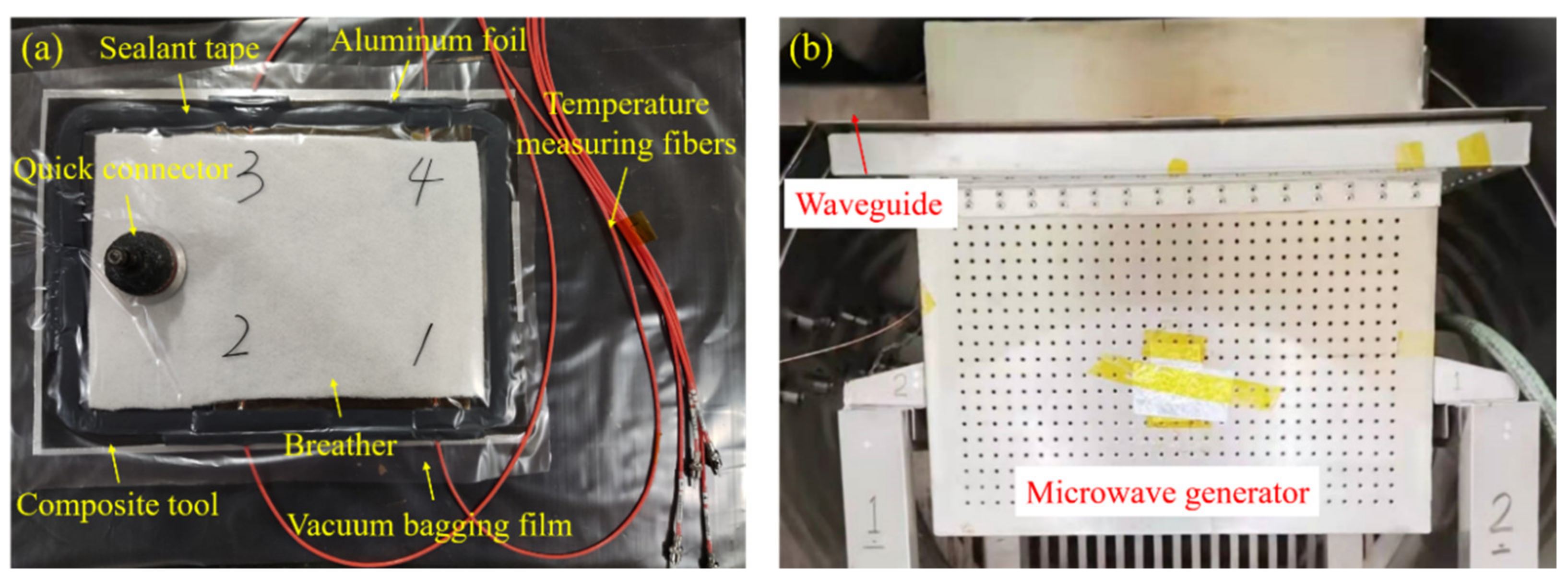
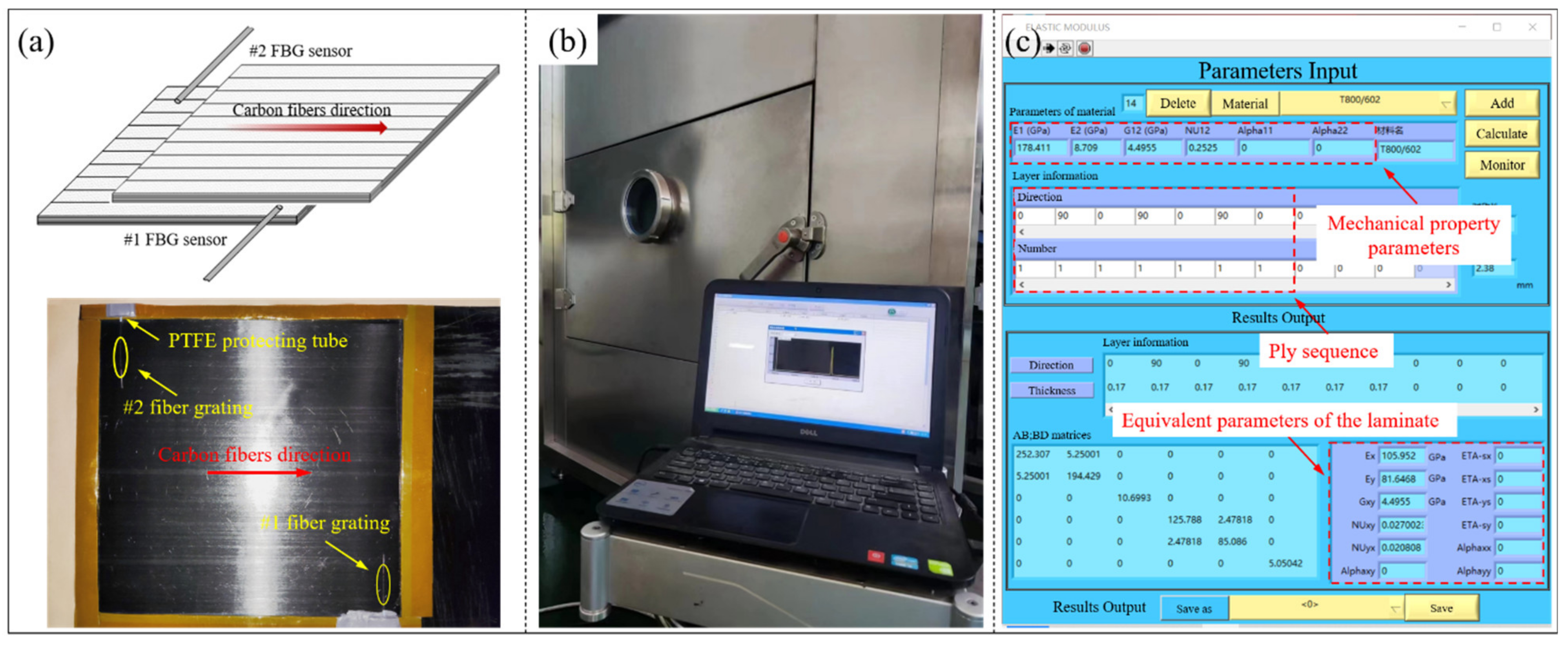
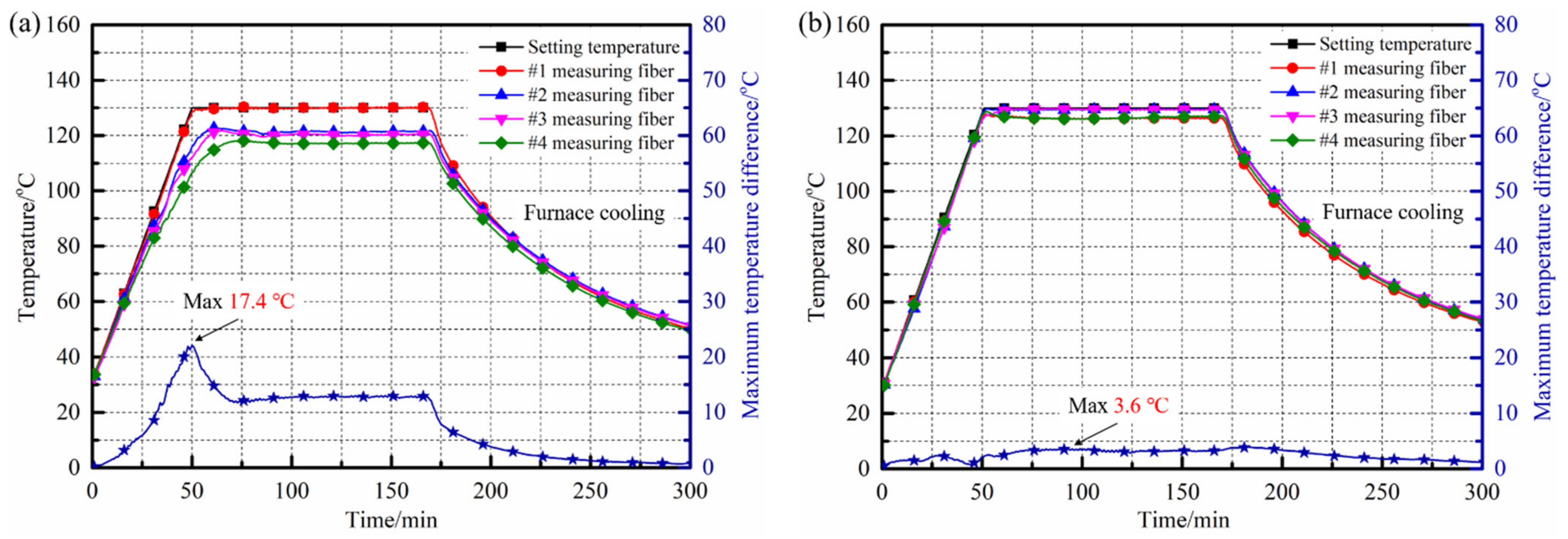
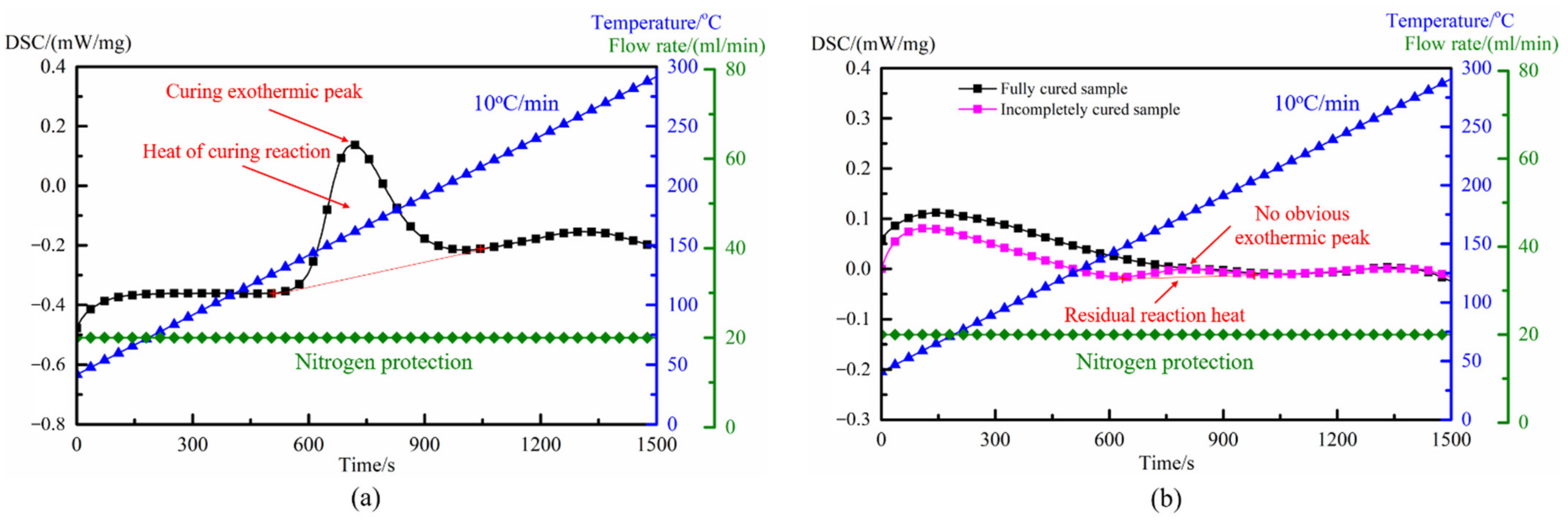
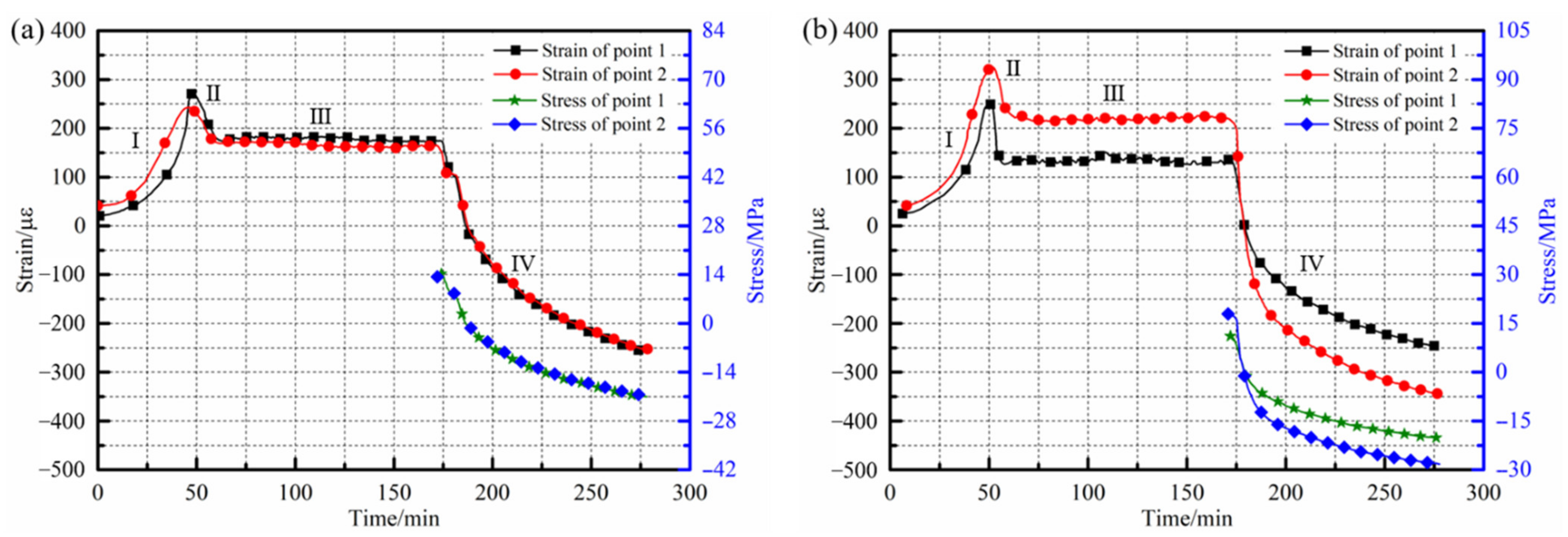
| Number | Quantity of Generators | Working Locations | Number | Quantity of Generators | Working Locations |
|---|---|---|---|---|---|
| (1) | 1 | 1 | (13) | 4 | 2/3/7/8 |
| (2) | 2 | 1/5 | (14) | 4 | 2/4/6/8 |
| (3) | 2 | 2/8 | (15) | 5 | 1/2/4/6/8 |
| (4) | 2 | 3/7 | (16) | 5 | 1/2/3/7/8 |
| (5) | 2 | 4/6 | (17) | 5 | 3/4/5/6/7 |
| (6) | 2 | 4/8 | (18) | 6 | 1/2/3/5/7/8 |
| (7) | 3 | 1/2/8 | (19) | 6 | 1/2/4/5/6/8 |
| (8) | 3 | 1/3/7 | (20) | 6 | 1/3/4/5/6/7 |
| (9) | 3 | 4/5/6 | (21) | 6 | 2/3/4/6/7/8 |
| (10) | 4 | 1/2/5/8 | (22) | 7 | 1/2/3/4/6/7/8 |
| (11) | 4 | 1/3/5/7 | (23) | 7 | 2/3/4/5/6/7/8 |
| (12) | 4 | 1/4/5/6 | (24) | 8 | 1/2/3/4/5/6/7/8 |
| Number | Working Locations | CoV | Number | Working Locations | CoV |
|---|---|---|---|---|---|
| (1) | 1 | 0.405 | (13) | 2/3/7/8 | 0.318 |
| (2) | 1/5 | 0.358 | (14) | 2/4/6/8 | 0.335 |
| (3) | 2/8 | 0.397 | (15) | 1/2/4/6/8 | 0.353 |
| (4) | 3/7 | 0.351 | (16) | 1/2/3/7/8 | 0.335 |
| (5) | 4/6 | 0.394 | (17) | 3/4/5/6/7 | 0.338 |
| (6) | 4/8 | 0.407 | (18) | 1/2/3/5/7/8 | 0.357 |
| (7) | 1/2/8 | 0.399 | (19) | 1/2/4/5/6/8 | 0.328 |
| (8) | 1/3/7 | 0.335 | (20) | 1/3/4/5/6/7 | 0.314 |
| (9) | 4/5/6 | 0.379 | (21) | 2/3/4/6/7/8 | 0.307 |
| (10) | 1/2/5/8 | 0.389 | (22) | 1/2/3/4/6/7/8 | 0.373 |
| (11) | 1/3/5/7 | 0.314 | (23) | 2/3/4/5/6/7/8 | 0.304 |
| (12) | 1/4/5/6 | 0.326 | (24) | 1/2/3/4/5/6/7/8 | 0.328 |
| Heating Mode | Sample Position | Weight/mg | Residual Heat/(J·g−1) | Total Reaction Heat/(J·g−1) | Curing Degree |
|---|---|---|---|---|---|
| Traditional heating device | 1 | 4.07 | 0.13 | 77.32 | 99.83% |
| 2 | 4.38 | 4.45 | 77.32 | 94.24% | |
| 3 | 6.84 | 3.91 | 77.32 | 94.96% | |
| 4 | 3.77 | 1.99 | 77.32 | 97.43% | |
| Regulating device | 1 | 3.84 | 0.72 | 77.32 | 99.07% |
| 2 | 4.37 | 0.17 | 77.32 | 99.78% | |
| 3 | 4.43 | 0.29 | 77.32 | 99.62% | |
| 4 | 4.96 | 0.77 | 77.32 | 99.01% |
| Heating Mode | Maximum Strain/µε | Insulation Strain (µε) | Residual Strain/µε | |
|---|---|---|---|---|
| Traditional heating device | Point 1 | 251.97 | 135.71 | −246.87 |
| Point 2 | 326.92 | 220.06 | −345.69 | |
| Regulating device | Point 1 | 273.01 | 180.71 | −255.84 |
| Point 2 | 242.82 | 165.18 | −251.69 | |
Publisher’s Note: MDPI stays neutral with regard to jurisdictional claims in published maps and institutional affiliations. |
© 2022 by the authors. Licensee MDPI, Basel, Switzerland. This article is an open access article distributed under the terms and conditions of the Creative Commons Attribution (CC BY) license (https://creativecommons.org/licenses/by/4.0/).
Share and Cite
Guan, C.; Zhan, L.; Yao, S. Finite Element Simulation and Experimental Research on Uniformity Regulation of Microwave Heating of Composite Materials. Polymers 2022, 14, 3484. https://doi.org/10.3390/polym14173484
Guan C, Zhan L, Yao S. Finite Element Simulation and Experimental Research on Uniformity Regulation of Microwave Heating of Composite Materials. Polymers. 2022; 14(17):3484. https://doi.org/10.3390/polym14173484
Chicago/Turabian StyleGuan, Chenglong, Lihua Zhan, and Shunming Yao. 2022. "Finite Element Simulation and Experimental Research on Uniformity Regulation of Microwave Heating of Composite Materials" Polymers 14, no. 17: 3484. https://doi.org/10.3390/polym14173484
APA StyleGuan, C., Zhan, L., & Yao, S. (2022). Finite Element Simulation and Experimental Research on Uniformity Regulation of Microwave Heating of Composite Materials. Polymers, 14(17), 3484. https://doi.org/10.3390/polym14173484







